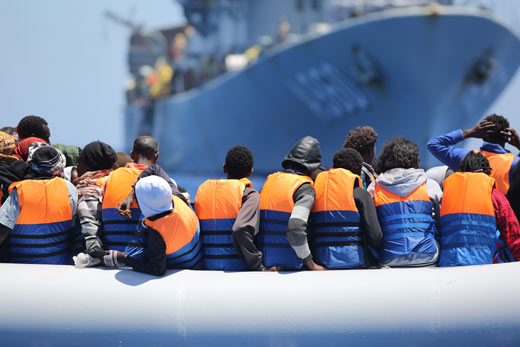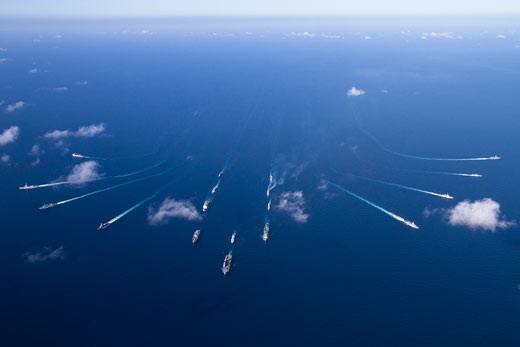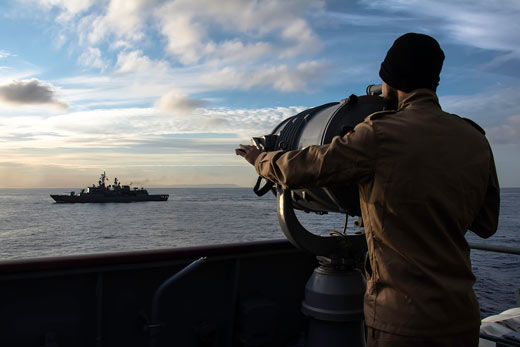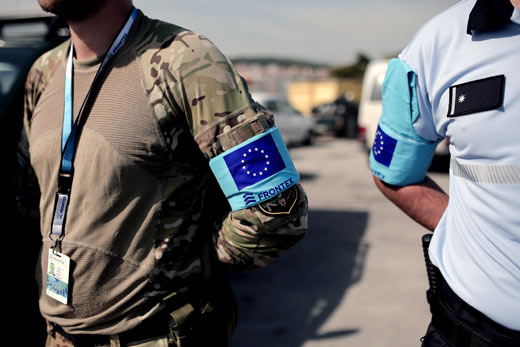ARTICLE
Militarising migration? EU and NATO involvement at the European border
In European policies towards migration, there is a growing involvement of security actors, such as NATO and the EU’s Common Security and Defence Policy (CSDP). The CSDP is running EUNAVFOR Sophia since May 2015 in the Central Mediterranean and NATO deployed its Standing NATO Maritime Group 2 (February 2016) in the Aegean as well as Operation Sea Guardian (July 2016) in the Mediterranean. To what extent are the EU and NATO involved as security actors, with what means and to what end? Are they effective in reaching the goals they set out to do, do the EU and NATO work well together on migration issues and lastly, how to assess their involvement? Does the involvement of these security and defence actors point to a militarisation of migration and what could be the repercussions of that?
In 2017, president Donald Trump called for NATO to pay more attention to terrorism, immigration and Russia. In his speech he said that "NATO of the future must include a great focus on terrorism and immigration", while not mentioning the importance of the Article 5 guarantee. Although Secretary-General Jens Stoltenberg stated that migration is not one of the core tasks of NATO, but it does have a role to play assisting others, it is likely that the Trump presidency will continue to press the issue at the NATO summit in July 2018.[1] NATO as a politico-military organisation could again be more geared towards ‘law enforcement at sea’ as an extension of NATO maritime security strategy and its counter-terrorism task.
Indeed, according to a number of authors, there are two tendencies in European policies towards migration. The first is its ‘externalisation’ and the second a growing role of security actors in migration management. Externalisation of migration policies points to an increasing emphasis on stemming the incoming flows through the combined use of development, diplomacy, security and trade policies.[2] In practice, it comes down to a process through which the European Union outsources a share of the control of its borders beyond its own territory to countries of origin and transit.[3] A second trend, which is at the same time part of this externalisation, is the growing involvement of security actors, such as NATO and the EU’s Common Security and Defence Policy (CSDP). This article looks specifically into this second trend.
EUNAVFOR Sophia
Until April 2015, the criminal aspect of irregular migration in the Central Mediterranean was primarily perceived as an Italian problem as opposed to a European concern. Italy had tried to propose a maritime operation similar to that of EUNAVFOR Sophia in late 2013, but did not receive support from the other EU Member States. This changed after a shipwreck on 18 April off the Libyan coast that cost more than 650 lives. This well mediatised disaster led to an extraordinary European Council on 23 April 2015, at which Heads of States and Governments invited the High Representative to “immediately begin preparation for a possible CSDP operation”(European Council 2015).[4] With an unprecedented speed for launching CSDP operations, the operation was officially established on 22 June.

© Ejército del Aire Ministerio de Defensa España / Flickr
Aeroplane as part of EUNAVFOR Operation Sophia.
The core mandate of the operation is to undertake systematic efforts to identify, capture and dispose vessels and enabling assets used or suspected of being used by migrant smugglers or traffickers, in order to contribute to wider EU efforts to disrupt the business model of human smuggling and trafficking networks in the Southern Central Mediterranean and prevent further loss of life at sea. The operation was divided into three phases that were supposed to be sequential. Phase one ran until 7 October 2015. It focused on information gathering on the High Seas. On 7 October 2015, EUNAVFOR MED transitioned into the first part of phase two (Alpha), which focuses on the boarding, search, seizure of vessels suspected of being used for human smuggling on the High Seas. Part two of phase two (Bravo) was to expand this activity to the territorial waters of Libya, and in phase three the operation would also include action on Libyan territory. Phase two Bravo and phase three have not been reached so far, because the EU has not been able to get a legal mandate to operate in Libyan territorial waters and on Libyan territory.
EUNAVFOR MED continued to build on its limited original mandate by disrupting trafficking networks, bringing the perpetrators to justice and seizing their assets by improving on its cooperation with Member State authorities, EUROPOL, FRONTEX, the European Asylum Support Office (EASO) and EUROJUST, as well as through increased intelligence and police-cooperation with third countries.[5] In June 2016, two additional tasks were added to Sophia’s mandate: training the Libyan coastguard and navy, and contributing to the implementation of the UN arms and oil embargo on the high seas.
Operation Sophia has been heavily criticized from its inception
The Operation has been heavily criticized from its inception. Most criticism is directed at the inability or even impossibility of reaching its initial goals, because a unified and effective government in Libya is a precondition of ‘Sophia’ operating in the territorial waters of Libya and on its territory. Because of the complex political situation in Libya these preconditions are not forthcoming in the short term. Failing to be able to operate in Libyan waters meant that there were unintended consequences of smugglers adapting and sending migrants to sea in unseaworthy boats, which resulted in a higher death toll at sea. A 2017 House of Lords report concluded that there is “little reason to renew the mandate of Operation Sophia”, but that the search and rescue work, which has saved many lives, should continue, although in more suitable vessels.[6] The House of Lords report found that “A naval mission is the wrong tool with which to tackle migration in the central Mediterranean. There is little justification for the deployment of high-end naval and air assets for the tasks being undertaken by Operation Sophia in Phase 2A. (…) As the Government told us, there are cheaper and more suitable ships to continue the essential task of search and rescue, which could be deployed in place of the mission in continuing to save lives.” (Paragraph 46).
The purpose of Operation Sophia has gone through a number of frames since 2015: from a decisive military instrument to disrupt traffickers, to a capability building purpose, to implementing the UNSC embargos on oil and arms, to a search and rescue purpose and lastly, to a more traditional naval situational awareness operation.[7] Its mandate is now running until 31 December 2018.

© Frontex
Migrants in front of the Belgian vessel Godetia for Operation Triton in 2015.
Sophia is not the only EU actor targeting migrant smuggling in the Mediterranean. Frontex is also present with a border security operation. The Frontex operation Triton was launched in November 2014 to conduct border control and surveillance in the Mediterranean. Effective as of February 2018, a new Joint Operation Themis replaces Triton. Themis will be more geared towards intelligence gathering on foreign fighters, terrorist threats and organised crime at the external borders. It operates off the Italian coast and in Italian reception centres and covers a wider area than in which Triton operated and which is covered by Operation Sophia. Frontex responds with Operation Themis to the shift in illegal migration patterns away from the Central Mediterranean route to the Western route. Its activities will span from the Eastern Mediterranean shores of Turkey to the banks of Morocco on the far West, and will include countries such as Egypt, Albania, Tunisia or Algeria.
The EU is a multifaceted actor with a lot of resources to address the illegal migration from root causes to integrating migrants and refugees in the EU member states’ societies. The focus seems to be mostly on the ‘gate-keeping’ function of border management, deploying a military naval mission, reinforcing border security through a wider mandate of Frontex and building capacity of third countries for border management. This is also reflected in the continuously rising budgets for border management. The Commission’s proposed new seven-year budget allocates €34.9 billion to Migration and Border Management, a significant boost from the €18 billion earmarked for ‘security and citizenship’ in the current Multi-annual Financial Framework (MFF).
NATO’s migration operations
22 countries are both members of the EU and of NATO. Despite this large overlap in membership NATO has deployed a naval mission dedicated to stem flows of migration, in addition to the EU NAVFOR Med Operation. Germany, Greece and Turkey took the initiative to ask NATO to take up a naval mission in the Aegean sea. Since February 2016, NATO warships that are part of the rotating Standing NATO Maritime Group 2 (SNMG2) are tasked to conduct “reconnaissance, monitoring and surveillance of illegal crossings in the stretch of sea between Turkey and Greece.” Led by Germany, the fleet of seven warships operates in both international waters and in the territorial waters of Greece and Turkey. While the NATO fleet does not directly engage in push-back activities, it provides real-time information to Greek and Turkish coast guards and to Frontex on the location of refugee and migrant boats. The fleet also conducts intelligence activities at sea, observing smugglers’ modus operandi.

© German Navy photo by Photographer PO1/OR-6 Alyssa Bier
During NATO-Exercise Trident Juncture 2015, eighteen ships from six different Task Groups are participating in a manoeuvring exercise. The units of Standing NATO Maritime Group 2 (SNMG2) are sailing in the Mediterranean Sea participating in multinational exercises and Operation Active Endeavour.
These types of activities are not alien to the Alliance. NATO’s latest Strategic Concept of 2010 mentions ‘the illegal trafficking of people’ as one of the challenges that threaten the Alliance’s security. Moreover, the March 2011 Alliance Maritime Strategy, that followed NATO’s Strategic Concept, also considered maritime operations in support of maritime security as part of its remit. These activities can entail “surveillance and patrolling and sharing information (…) in support of law enforcement”. [8]
The question is why NATO was chosen as the right framework and not either CSDP or Frontex was considered the best framework to take up the task to support activities of Greece and Turkey to manage migration to Europe? The SNMG2 is a standing naval group which is present in the Mediterranean anyhow as part of its ongoing training activities and at the time also in the context of the NATO Operation Active Endeavour. Active Endeavour is a part of the activation of Article 5 after the terrorist attacks on the US in 2001. There is therefore a very practical reason: why not put the naval group that was already in the area to use very swiftly towards a pressing political issue? It would mean that scarce resources could then be optimally used in assistance of Greece, Turkey and the EU’s Frontex. Another logic brought forward was that the EU only has access to Greek territorial waters, while the SNMG2 can navigate the whole stretch of the Aegean with access to both Greece’s and Turkey’s territorial waters. There is, of course, also the matter of the acceptability of the NATO framework to Turkey, to which it is a member, in contrast with the EU.
The naval cooperation between the EU and NATO featured prominently in the 2016 Joint Declaration on EU-NATO cooperation, which marks the revisited intention of the two organisations to cooperate more closely
The Aegean operation is not the only NATO activity in the Mediterranean. At the NATO Warsaw Summit in July 2016, a few months after the decision to deploy the SNMG2 in the Aegean, NATO announced the transformation of the Active Endeavour counter-terrorism mission in the Mediterranean to a broader non-Article 5 maritime security operation. The new operation received the name Operation Sea Guardian. It operates alongside EUNAVFOR MED in the Central Mediterranean and is aimed at improving the maritime situational awareness in the area, sharing its intel with the EU operation as well. NATO can also provide, upon request, logistical support and other capabilities such as re-fuelling at sea and medical support.
Besides practical, operational advantages there are also a number of political perks to the deployment in the Aegean. The operation was also a good show of EU-NATO cooperation and solidarity. The naval cooperation between the EU and NATO featured prominently in the 2016 Joint Declaration on EU-NATO cooperation, which marks the revisited intention of the two organisations to cooperate more closely.[9] Particularly the fact that two member states that have been blocking this cooperation, Greece and Turkey, were involved, could be framed as a diplomatic step forward. NATO, an organisation that has been searching for relevance after the end of the Cold War and for a proper role in the complexities of the new security environment, was happy to be seen as relevant to one of the most pressing issues facing Europe.

© German Navy photo by Photographer PO1/OR-6 Alyssa Bier
A sailor of SNMG2 flagship German frigate HAMBURG is visually sending a message in morse code via spotlight in November 2015, during Operation Active Endeavour.
It is difficult to assess the practical effectiveness of the two NATO operations. Operation Sea Guardian’s mission is to enhance maritime security in general, but also focuses on possibly terrorist related trade flows of arms and fighters. Sea Guardian operates in layers: First, the OSG task group makes several surge deployments per year into “intel-driven focus areas in the Mediterranean. The group will monitor patterns of life, track vessels of interest and conduct boardings on suspicion of illicit activity.”[10] The other layer is rapid response. There are on-call national assets that are ready at very short notice to conduct interdiction operations at sea should intelligence suggest that such an event is required. The Greek Navy, for instance, has offered special forces support out of Souda Bay. NATO does bring specific capabilities to the table with deploying for example special forces, submarines, maritime patrol aircraft, and E-3 airborne early warning aircraft.[11]
The value of Sea Guardian’s cooperation with operation Sophia and the activities of Frontex are viewed with scepticism, as these actors represent a response to the migration issue by policing and military actors. Particularly both military operations are often seen as being political and only symbolic in nature. Reportedly, NATO and the EU share daily situation reports and sailing intentions as well as schedules for air, surface and submarine operations. At the very least, operational logic would demand sharing information as it prevents duplication in tasks and helps build a bigger picture of maritime activities in the central Mediterranean. Whether these operations are the right tools in the face of the complex problem of mass and illegal migration, is another issue.
To conclude: militarisation of migration?
Tasking NATO with assisting the Turkish and Greek coast guards in the Aegean has clear practical but also political advantages. That the initiative originated from the German government is not a surprise, as German Chancellor Angela Merkel was under heavy pressure by public opinion, her own party and the CSU to reduce the inflow of migrants and sought a multilateral framework to assist the Greek and Turkish border controls. The SNMG2 could be deployed very quickly, which was welcomed by Merkel and other NATO member states as it created the image of governments that were acting swiftly and decisively. Under more political pressure than ever with the relative success of the Alternative für Deutschland in the general elections in 2017, Merkel continues to signal the urgency she attaches to the migration issue. In a speech in Munich in June 2018, she told an audience of Members of European Parliament: “If we fail to provide a common answer to questions of illegal migration, the foundations of the European Union will be called into question (…) Action is really needed here, or the freedom of movement, and with it the internal market, is in peril”.[12]

© European Union
Armband of a Frontex member
These words constitute a clear example of a ‘speech act’ to alleviate the migration issue to a status above normal political questions.[13] In Merkel’s vocabulary, the primary subject of security (that which deserves protection) is not only the citizens of the EU, but the EU itself. Merkel’s words were directed at both German as well as European audiences as the conception of migration as an existential problem for the EU is persevering. For example, the new populist Italian government was recently elected on an anti-migration - and in extension- an anti-EU platform, with the next important elections, of the European Parliament, already on the horizon. In this context of the meaning of migration, it is to be expected that high-end capabilities and the ability to protect those capabilities that are associated with the military is called upon.
However, there is a dilemma involving the military in law enforcement tasks at Europe’s sea borders, as is the case in the Mediterranean. Border security and migration are in principle civilian tasks, but in cases where civilian agencies are overwhelmed, not up to the task and swift action is needed, taking recourse to military means is a logical step. The navies of the EU and NATO countries have capabilities that coast guards do not have, such as advanced intelligence, surveillance and reconnaissance means. Their ships are faster and have the ability to surge, if needed. The European Council’s conclusion on migration also call for “a further intensification of the efforts to stop smugglers operating out of Libya or elsewhere”, which probably means that the EU and NATO’s naval operations will not be winding down soon.[14]
Apart from practical and operational aspects, there are clearly political ones for bringing in the military in the migration issue
Apart from these practical and operational aspects, there are clearly political ones for bringing in the military in the migration issue. The fact that the EU CSDP operation Sophia and NATO’s operation Sea Guardian have been deployed in the Mediterranean highlights a sense of urgency by European states. Amidst growing unrest over the ‘migration crisis’ and domestic political pressure to undertake decisive action, deploying the military signals the highest political priority. This political and, for some part, symbolic side to engaging the military is part of political life. There is, however, the risk of an adverse effect. Recourse to naval forces might crowd out solutions that have a more sustainable effect. The military is able to act swiftly and robustly, but cannot indefinitely be assigned to border duties. Most capabilities, such as ships, helicopters and patrol aircraft that are provided to NATO and to CSDP-operations are member state owned.
Most of these could also be offered to Frontex and deployed in this more appropriate setting of managing Europe’s borders. Moreover, these high-end capabilities are often not suited to many migration related (low-end) tasks. Short-term military solutions should also not divert policy makers from a focus on root causes of migration and sustainable solutions to migration and mobility that will remain a part of Europe’s reality. It also holds the potential side-effect that engaging the military will add to the perception of migrants in general as a security risk. This has obvious repercussions for the integration in European societies of refugees and migrants and for attention to that should be devoted to the human rights aspects of the migration issue.
In sum, while the military can bring short term backstop solutions, the nature of the migration issue calls for recourse to the military to be the exception rather than the rule. Better cooperation between CSDP and FSJ assets of the EU, embedded in a well-functioning common asylum policy and a strategy towards transit countries and root causes of migration, would be the preferable course of action.

